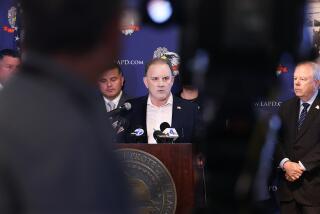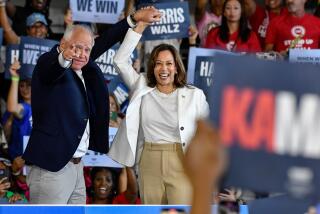Union disunity
Over the last few months, the American labor movement has faced a new and terrible threat -- from within. Fierce internecine fighting among a number of national unions has threatened to destroy carefully built coalitions and distracted the movement at a time when it can’t afford to lose focus.
The battle has been centered in New York and Washington, where the national unions are headquartered. But the city where it could do the most harm is Los Angeles.
The troubles began within Unite Here -- a union that has only been around since 2004, when Unite (the apparel workers union) merged with Here (the hotel workers union). The two groups were among labor’s stars. Here had turned Las Vegas into a union town, a place where lowly hotel workers could step into the middle class; Unite had won epochal battles for Southern textile workers; and both unions had led the fight for America’s growing immigrant workforce.
The new union’s two halves, however, never melded into a coherent whole. Each had a distinct culture increasingly at odds with the other’s.
This last winter, as it became clear that the leaders of the former Here would soon have the votes to oust the leaders of the former Unite from their leadership posts in the merged union, the Unite side voted to unmerge and affiliate itself instead with the Service Employees International Union, or SEIU -- the nation’s most dynamic and powerful union.
The de-merger, though, only intensified the conflict. Each union maintained that it had rights to assets the other had brought to the merger: The hotel workers, who now control Unite Here, laid claim to financial assets that had been Unite’s before the merger (including Amalgamated Bank, the nation’s last labor bank). The apparel workers insisted they still had the right to organize hotels because their own industry, domestic clothing and textile manufacturing, had largely collapsed.
Each side put pressure on the other, but the SEIU-Unite side really brought out the big guns. Throughout March and April, it phoned and mailed members of the hotel locals in Los Angeles, San Francisco, Las Vegas and elsewhere, urging them to turn against their leaders and come over to the other side. This, in turn, raised the hackles of the leaders of other unions, who were clearly perturbed by the spectacle of one union destabilizing another.
In Los Angeles, tensions between the SEIU -- particularly its fabled janitors local -- and the hotel workers local reached fever pitch and extended as well to the L.A. County Federation of Labor (L.A.’s central labor council), which passed a resolution condemning the SEIU’s campaign. The federation’s leader, Maria Elena Durazo, came out of the hotel workers local and remains on the executive board of Unite Here.
Which brings us to why the battle creates such peril for Los Angeles labor.
For more than a dozen years, the hotel and janitors locals have been the heart and muscle of the L.A. labor movement -- and more broadly of the progressive forces that have transformed local and even state politics.
Both unions largely represent immigrant workers, for whom they fought loudly and brilliantly and won groundbreaking contracts. Both have founded key civic institutions: The Los Angeles Alliance for the New Economy, which has devised many local living wage ordinances and local hiring agreements, was initially a creation of the hotel workers. Both have mobilized many thousands of Latino and immigrant voters well beyond their own ranks, providing more foot soldiers for the County Federation’s election operations than any other union.
The SEIU’s Los Angeles locals represent nearly half the members in the 800,000-member County Federation. If those members opted to withhold dues or their participation in the federation’s campaigns, they could cripple the most significant force in California politics. In the ‘90s, labor played a decisive role in transforming the congressional and legislative districts in Los Angeles’ suburbs from Republican to Democratic. Last November, Barack Obama carried seven Southern California congressional districts currently represented by Republicans. A push by a unified labor movement over the next three elections could turn L.A.’s exurbs Democratic too, and give labor-friendly Democrats a decisive two-thirds supermajority in both houses of the Legislature.
As the state’s largest public-sector and healthcare union, the SEIU would benefit greatly from such a change.
Over the last two weeks, fortunately, the unions seemed to have pulled back from the specter of all-out civil war. The SEIU stopped its campaigns within the three hotel locals. The new national leadership of Unite Here (that is, the leaders of the hotel side) agreed to settlement terms suggested by an independent arbitrator, and though the SEIU-Unite leaders rejected those terms, talks continue. In Los Angeles, the SEIU leaders met Tuesday with Durazo, and the County Federation is still in one piece.
With President Obama in the White House, Democrats running Congress and a bill making it easier for workers to join unions hanging in the balance on Capitol Hill, this should be a time for unions to work together, not pull apart. And nowhere more than in Los Angeles, where the rewards of solidarity should be plain for all trade unionists to see.
More to Read
Inside the business of entertainment
The Wide Shot brings you news, analysis and insights on everything from streaming wars to production — and what it all means for the future.
You may occasionally receive promotional content from the Los Angeles Times.










